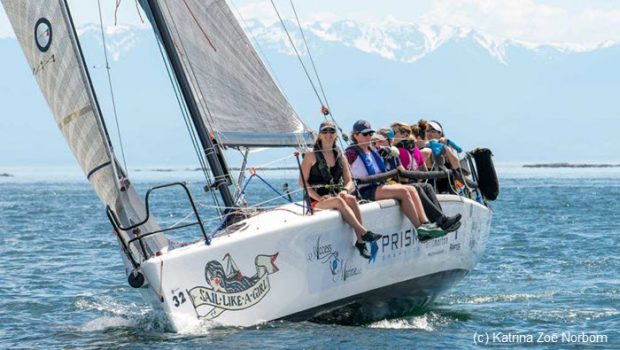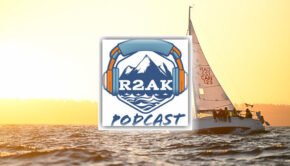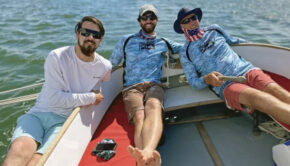The Race to the Race
Published on June 19th, 2018
(June 19, 2018; Day 3) – We’re not sure what motivates people to take on the Race to Alaska. After three editions, there are no longer any secrets or misconceptions. But people came knocking again in 2018 to tackle the 750 cold water miles from Port Townsend, Washington to Ketchikan, Alaska.
It is heartening to know the seemingly soft and technically reliant society of today is still able to stick it out there. Teddy Roosevelt would approve…
“Nothing in the world is worth having or worth doing unless it means effort, pain, difficulty… I have never in my life envied a human being who led an easy life. I have envied a great many people who led difficult lives and led them well.”
After a qualifying stage thinned the field, 31 teams lined up on June 17 for the final 710 miles from Victoria, BC to the land of feisty salmon, idyllic scenery, and an incredibly rich Alaska Native culture. But the miles have not come easy.
Teams are still dealing with the fat man of a high-pressure system that was squashing the Strait of Georgia under its sweaty mass. Teams sailed, stalled, rowed, pedaled, advanced, and retreated on the tides. Most faired well enough, but at least one team spent four hours sailing, rowing, pedaling, eeking every wind shift only to go sideways four miles. Six ferries passed and waved while they were holed up in what felt like their own personal wind hole.
Yesterday was a game of playing every shift, staying alert in the sunbaked lethargy that comes on the sweaty underside of a high-pressure system. It’s getting sticky down here, the blisters are growing, and from the last to the first, teams wrung out every drop of wind in a high stakes, sweaty, slow play to stay off the oars for as many minutes as possible.
At the tail end of the fleet’s dog day, Team Dock Rat looks to have finally gotten a wind that will let him make progress in the right direction. Since the start, soloist Jim Edmark has been working like mad to get out of the harbor, buck the first tide, and make any progress north.
Jim’s alone, sailing his house (his Haida 26 is a stoutly built boat/home), and in the flat calm scorcher of the first two days of the race, human power option is his dink—he’s literally towing his house with a rowboat. A late afternoon system has finally freed him from near Victoria orbit, and he’s starting to make miles in the right direction… which is a good thing since he already shipped his outboard to Ketchikan.
As yesterday’s sun doused itself into the race’s western horizon, Team PT Watercraft (Gougeon 32 catamaran) was sailing into the literal and proverbial sunset a few flat, calm miles ahead of First Federal’s Team Sail Like a Girl (Melges 32, above). For these two teams in the race’s hard-fought, slowly moving leading edge, you’d be hard-pressed to find two more dissimilar teams vying for the top spot.
Both talented, riding high-twitch boats that carry the hopes of their niche followers, but other than their recent “I could win this thing…” realization (and our realization on the final edit that this west coast race is being led by two designs birthed from the midwest), these teams would be hard pressed to find more different ways to make a run at the money.
Team PT Watercraft is running wild and solo on a trailerable catamaran that 40 years after construction, still looks like the sailing manifestation of future promised at the ‘69 world’s fair; flying cars, robot maids, tail fins on Cadillacs—his boat looks like it sailed out of the Jetsons.
The Gougeon 32 was one of Jan Gougeon’s designs, a culmination of the most boat you could pack onto a road-legal trailer. Narrow for its length at 8’, the stability comes from water ballast that can be scooped in and drained out of the hulls as it tacks, adding 600 pounds of water weight to the high side whenever it needs it, or keeping it light when the conditions merit.
The solitary crew member, Russell Brown, is one of those sailors whose ability seems to have taken hold at near cellular levels. He wanted to run solo because he knows what good looks like, and didn’t want to spend 750 miles correcting and/or being silently resentful of the less than perfect of whoever came along.
When we saw him in conditions flat enough to cause self-doubt in plate glass, Russell was eeking out 4 knots, sailing and occasionally pedaling into the dusk, his stern wake the only ripple on the water. He was smiling despite the broadside of cameras, drones, and questions coming from the media boat. “You’re wasting a lot of fuel and film, guys.” As much as he liked sailing well, there’s a growing part of him considering heading in the wrong direction until someone else can absorb the attention of the frontrunner. He just wants to sail.
A squinted gaze to the south and the First Federal logo was just visible on the black rig of Team Sail Like a Girl. Different rig, different boat, whole different program. Russell is one dude on a couple of hulls; First Federal’s Team Sail Like A Girl is six women on one.
Sailing for a mission, and sponsored to near NASCAR proportions, their Melges 32 retains water ballast as well, but inside the skins of humans that scurry from the low to the high side on every tack. Even their fun is different.
Russell was having a blast, sailing self-contented and drinking enough coffee to fuel his compulsion. Team Sail Like a Girl was polishing off their post salmon dinner with a signature cocktail that includes some proprietary proportion of whiskey and Swedish Fish.
It was simultaneously an inside joke, the sign of a gelling crew, and our cue to politely leave before we had to try it. Light, quiet, and alone, or together with whiskey. Two ways to crack the same code that, at the moment, seems to be in the ballpark of equity.
Today broke on a southerly breeze that snuck in under cover of darkness and rolled north through the fleet, bringing with it the chase pack of teams, and a fresh relevance on everything we wrote the night before. As day dawns on Day 3, First Federal’s Team Sail Like A Girl is still in a race for first, but now is fending off Team Ptarmigan’s Colorado-style seamanship, Teams Lagopus (Olson 30) and Wild Card (Santa Cruz 27) covering each other’s tacks half a horizon behind, and another six teams on the move and praising their spinnakers and the holy whoever a little farther back.
After a three-day row show, the race is back, downshifting from the speed of sunburn to fast enough to warrant its name. Teams have popped the chutes, crossed their hearts, and crossed their fingers, setting their sites on that next team to windward, and laying a course for Seymour Narrows, the gatekeeper to R2AK’s back 9.
Seymour Narrows is a fabled tidal river that flows with 14 knots of authority. When the tide goes out, it’s the escalator to Johnstone Strait and the next level wilderness beyond. On the flood, Seymour is the bouncer that sends you to the back of the line, makes you hang out in Comox while everyone in front of you gets six hours farther ahead, everyone behind you gets six hours to catch up, and you get a chance to think about your choices.
No fighting it; even the 20,000-horsepower engines that cruise ships wrap themselves around take a number and wait.
Today, the water runs north in the Narrows until 1600 and will separate the fleet into those charging for the prize and teams who are forced to hang out in the Comox, tapping their feet and looking at their watches to get on the next northbound tidal train. There are hours to go, but if conditions hold, it seems like there could be ten teams that make it in before the drawbridge goes up. This is the race to the race.
Footnote: Team Mknotkrazee and Team Take Me To The Volcano are early to the DNF party.
Race details – Team list – Tracker – Facebook – Instagram
Background:
Race to Alaska, now in its 4th year, began with 47 teams signing up for the adventure of a lifetime. No motor, no support, through wild frontier, navigating by sail or peddle/paddle (but at some point both) the 750 cold water miles from Port Townsend, Washington to Ketchikan, Alaska.
To save people from themselves, and possibly fulfill event insurance coverage requirements, the distance is divided into two stages. Anyone that completes the 40-mile crossing from Port Townsend to Victoria, BC can pass Go and proceed. Those that fail Stage 1 go to R2AK Jail. Their race is done.
Thirty-nine conquered the first test on June 14, of which 31 lined up on June 17 for the start of Stage 2 from the southern tip of Vancouver Island. At least that was the plan. Race details.
Source: R2AK







 We’ll keep your information safe.
We’ll keep your information safe.